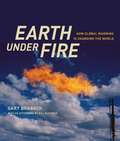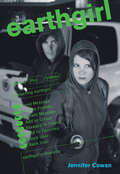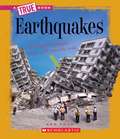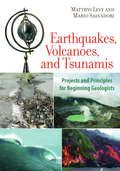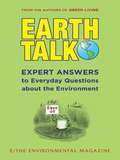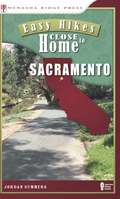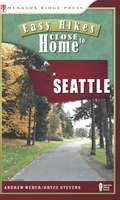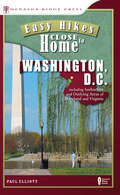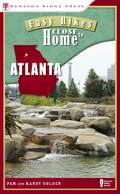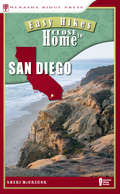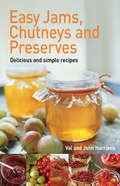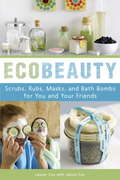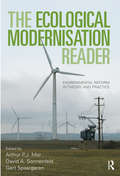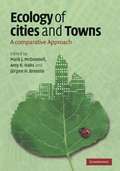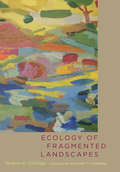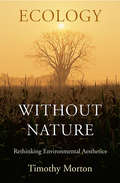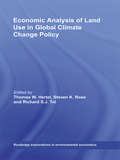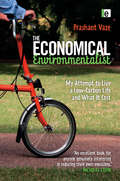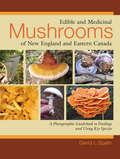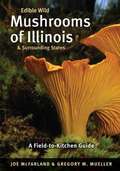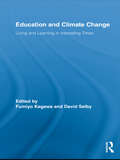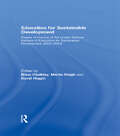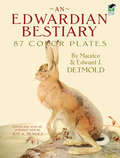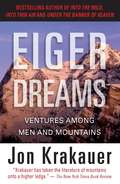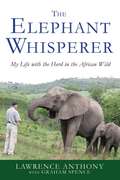- Table View
- List View
Earth under Fire: How Global Warming Is Changing the World
by Gary BraashEarth under Fire is the most complete guide to the effects of climate change now available. It offers an upbeat and intelligent account of how we can lessen the effects of our near-total dependence on fossil fuels using technologies and energy sources already available.
earthgirl
by Jennifer CowanA New York Times Editors' Choice Earthgirl follows the eco-evolution of sixteen-year-old Sabine Solomon, who is thrown into the fray one afternoon when she's riding her bike downtown to join her friends, and an idling minivan driver carelessly tosses leftovers from McDonald's out the car window, blindsiding Sabine and leaving her covered in plum sauce. When Sabine tosses the garbage back at the offensive driver, an altercation ensues that is captured on the videophones of her friends. In a technological blink, footage is posted on YouTube, and Sabine finds herself at the center of a heated eco-debate. A crusader is born.
Earthquakes
by Ker ThanWhat makes the earth quake, rivers flood, and volcanoes blow their tops? How do natural forces become natural disasters? Buckle your seatbelts and get ready for a bumpy ride to the center of the earth for a look at some of the wildest phenomena in the history of earth science!
Earthquakes, Volcanoes, and Tsunamis: Projects and Principles for Beginning Geologists
by Matthys Levy Mario SalvadoriWith fascinating experiments, models, and demonstrations, this scientific survey provides a vivid exploration of natural phenomena. Ideal for budding earth scientists, this in-depth resource demonstrates how to build a seismograph to record a simulated earthquake, compare pressure waves and shear waves--the two types of ground shocks--with a Slinky, and replicate a tsunami's destructive effect on a "coastline" built in a bathtub. The chapters answer questions such as Can animals "predict" earthquakes? How have various cultures explained the movement of the earth throughout history? and Why do some volcanoes ooze rivers of lava while others blow their tops? Additional topics include how to earthquake-proof homes, protect oneself during a tremor, and construct simple models to test seismographs.
EarthTalk: Expert Answers to Everyday Questions About the Environment
by E MagazineFrom the authors of the leading environmental handbook Green Living? the best of E?s nationally syndicated Q&A column, EarthTalk E / The Environmental Magazine has established itself as the leading independent environmental periodical since its debut in 1990. E reaches 180,000 readers per issue, and its website attracts up to 600,000 visitors a month. One of their most popular features is the column EarthTalk, now nationally syndicated in up to 1,700 newspapers, magazines, and websites. In EarthTalk, the editors of E answer readers? questions on the environment and the best ways to live green. EarthTalk gathers together the best of these questions and answers in a quick and easy guide for the average Joe (or Jane). Searching by subject or looking up questions in the index, readers can learn everything from the difference between wild and farmed salmon to the pros and cons of nuclear power. EarthTalk provides the essential tools and tips to living in harmony with the planet.
Easy Hikes Close to Home: Sacramento
by Jordan SummersCarefully researched on foot, Easy Hikes Close to Home: Sacramento introduces area residents and visitors to a wide array of the best and easy day hikes, from the atmospheric Sacramento Delta area to tranquil trails in the Cosumnes River Preserve. With detailed descriptions, novice hikers discover their choices with concise at-a-glance information highlighting details such as length, configuration, water required, exposure, trail traffic and surface, hiking time, season, facilities, scenery, and much more.
Easy Hikes Close to Home: Seattle
by Andrew Weber Bryce StevensSmall and lightweight, Easy Hikes Close to Home: Seattle contains 20 beginner-level hikes. With trails personally tested by both authors, this guide includes at-a-glance information (length, water required, trail traffic and surface, wheelchair accessibility, and more), GPS trailhead coordinates, directions, and clear maps.
Easy Hikes Close to Home: Washington, D.C.
by Paul ElliottFrom the central city through the suburbs to the foothills and mountains in the west and the lowlands in the east, this portable guide introduces 20 of the best easy day hikes in Washington, D.C. Filled with detailed descriptions, clear maps, and GPS coordinates, Easy Hikes Close to Home: Washington, D.C. contains a wealth of at-a-glance information, including length, configuration, water required, scenery, exposure, hiking time, facilities, special comments, and more.
Easy Hikes Close to Home: Atlanta
by Randy Golden Pam GoldenDay hiking in Atlanta and the surrounding areas has never been better - or easier. This guide, compiled by avid hikers Randy and Pam Golden, introduces residents and visitors to the area's best easy day treks. Carefully researched on foot, and filled with detailed trail notes, the book helps novice hikers discover their options with concise at-a-glance information highlighting factors such as location, access, directions, distance, and scenery. Included are both newly established trails and older trails ripe for rediscovery.
Easy Hikes Close to Home: San Diego
by Sheri McgregorNew trails have been established and old trails rediscovered, making the hikes in San Diego and the surrounding areas better than ever. Based on the author's own research, this handy guide introduces area residents and visitors to nearly two dozen of the best easy day hikes. Filled with detailed descriptions of each trail, Easy Hikes Close to Home: San Diego helps novice hikers discover their choices with clear maps and concise at-a-glance information highlighting details such as location, access, directions, distances, and scenery.
Easy Jams, Chutneys and Preserves
by John Harrison Val HarrisonThis book explains all you need to know to make your own delicious jams, jellies, marmalades, fruit butters, fruit cheeses, chutneys and pickles, including details of all the necessary equipment, how to choose the best fruit and vegetables to use, and how to make sure the jam sets properly to produce the best results.In these straitened times, more and more people are keen to save money by making jams, jellies and chutneys from the surplus of their own homegrown fruit and vegetables or from free fruit, such as blackberries, available in nearby hedgerows. Val and John Harrison show how easy it is to collect together the required ingredients and start making your own produce.
EcoBeauty
by Lauren Cox Janice CoxEcoBeauty has something for everyone. Crafty types will love the gift ideas, and even those of us who can barely make toast will be able to handle these recipes. Making beauty products at home is a great way to save money and help the environment, and these recipes will do all that plus give you gorgeous skin and hair. --Beth Mayall-Traglia, editor in chief of TotalBeauty.comFun, fresh bath and body recipes that are great for gifts, girls' nights, or everyday use!--Jill and Megan Carle, coauthors of Teens Cook and College CookingAttention DIYers! Finally, the ultimate natural-beauty "cookbook" packed with deliciously easy, eco-friendly recipes for getting gorgeous with fresh ingredients from the kitchen. A must-have for anyone who wants to be healthy, save money, and make the world a more eco-beautiful place.--Rona Berg, editor in chief of Organic Beauty magazine and author of Fast BeautyLotions and Toners and Soaps, Oh My!What's the hippest way to be green? When you whip up a batch of Avocado Hair Conditioner, not only will your hair be green (for about twenty minutes) but your lifestyle will, too. Natural beauty maven Lauren Cox is bringing bath and body into the eco-friendly future with 100 easy and economical projects, featuring au courant ingredients--hemp oil, green tea, soy milk, powdered kelp, goat's milk, and more--that are increasingly easy to find. Recycled bottling and green gift-giving ideas round out this stylish how-to manual for the DIY generation. So whether you are a crafty chica revitalizing your skin with an Espresso Yourself Facial Mask, a penny-pinching diva rocking some simple Green Tea Toner, or a chocoholic with a craving for Chocolate Brownie Lip Gloss, EcoBeauty has a money-saving, planet-loving, skin-pleasing creation for you.From the Trade Paperback edition.
The Ecological Modernisation Reader: Environmental Reform in Theory and Practice
by Arthur P.J. MolStructural environmental reform by firms and industries, governmental and intergovernmental agencies, non-governmental organisations (NGOs), and others is a worldwide phenomenon and the focus of this definitive collection. Includes a comprehensive introduction to and overview of Ecological Modernisation Theory; original, state-of-the-art review essays by distinguished international scholars; a selection of the best published works and debates from a quarter-century of related social science scholarship; an emphasis on environmental issues in Asian and other emerging economies; and an agenda for continued scholarship, policymaking, and practice. Accessible to students, policymakers, professionals, executives, and others interested in deeply understanding contemporary environmental issues and taking effective action for environmental solutions. Rigorous and sophisticated for use in graduate and advanced studies. Appropriate for courses in Sociology, Political Science, Policy Studies, Geography, Environmental Studies, Environmental Planning, Business, Economics, Asian Studies, Development Studies, and other fields.
Ecology of Cities and Towns
by Mark J. Mcdonnell Amy K. Hahs Jürgen H. BreusteThe unprecedented growth of cities and towns around the world, coupled with the unknown effects of global change, has created an urgent need to increase ecological understanding of human settlements, in order to develop inhabitable, sustainable cities and towns in the future. Although there is a wealth of knowledge regarding the understanding of human organisation and behaviour, there is comparably little information available regarding the ecology of cities and towns. This book brings together leading scientists, landscape designers and planners from developed and developing countries around the world, to explore how urban ecological research has been undertaken to date, what has been learnt, where there are gaps in knowledge, and what the future challenges and opportunities are.
Ecology of Fragmented Landscapes
by Sharon K. CollingeAsk airline passengers what they see as they gaze out the window, and they will describe a fragmented landscape: a patchwork of desert, woodlands, farmlands, and developed neighborhoods. Once-contiguous forests are now subdivided; tallgrass prairies that extended for thousands of miles are now crisscrossed by highways and byways. Whether the result of naturally occurring environmental changes or the product of seemingly unchecked human development, fractured lands significantly impact the planet’s biological diversity. In Ecology of Fragmented Landscapes, Sharon K. Collinge defines fragmentation, explains its various causes, and suggests ways that we can put our lands back together.Researchers have been studying the ecological effects of dismantling nature for decades. In this book, Collinge evaluates this body of research, expertly synthesizing all that is known about the ecology of fragmented landscapes. Expanding on the traditional coverage of this topic, Collinge also discusses disease ecology, restoration, conservation, and planning.Not since Richard T. T. Forman's classic Land Mosaics has there been a more comprehensive examination of landscape fragmentation. Ecology of Fragmented Landscapes is critical reading for ecologists, conservation biologists, and students alike.
Ecology without Nature: Rethinking Environmental Aesthetics
by Timothy MortonIn Ecology without Nature, Timothy Morton argues that the chief stumbling block to environmental thinking is the image of nature itself. Ecological writers propose a new worldview, but their very zeal to preserve the natural world leads them away from the "nature" they revere. The problem is a symptom of the ecological catastrophe in which we are living. Morton sets out a seeming paradox: to have a properly ecological view, we must relinquish the idea of nature once and for all. Ecology without Nature investigates our ecological assumptions in a way that is provocative and deeply engaging. Ranging widely in eighteenth-century through contemporary philosophy, culture, and history, he explores the value of art in imagining environmental projects for the future. Morton develops a fresh vocabulary for reading "environmentality" in artistic form as well as content, and traces the contexts of ecological constructs through the history of capitalism. From John Clare to John Cage, from Kierkegaard to Kristeva, from The Lord of the Rings to electronic life forms, Ecology without Nature widens our view of ecological criticism, and deepens our understanding of ecology itself. Instead of trying to use an idea of nature to heal what society has damaged, Morton sets out a radical new form of ecological criticism: "dark ecology."
Economic Analysis of Land Use in Global Climate Change Policy (Routledge Explorations in Environmental Economics)
by Thomas W. Hertel Steven K. Rose Richard S. J. TolLand has long been overlooked in economics. That is now changing. A substantial part of the solution to the climate crisis may lie in growing crops for fuel and using trees for storing carbon. This book investigates the potential of these options to reduce greenhouse gas emissions, estimates the costs to the economy, and analyses the trade-offs with growing food. The first part presents new databases that are necessary to underpin policy-relevant research in the field of climate change while describing and critically assessing the underlying data, the methodologies used, and the first applications. Together, the new data and the extended models allow for a thorough and comprehensive analysis of a land use and climate policy. This book outlines key empirical and analytical issues associated with modelling land use and land use change in the context of global climate change policy. It places special emphasis on the economy-wide competition for land and other resources, especially; The implications of changes in land use for the cost of climate change mitigation, Land use change as a result of mitigation, and Feedback from changes in the global climate to land use. By offering synthesis and evaluation of a variety of different approaches to this challenging field of research, this book will serve as a key reference for future work in the economic analysis of land use and climate change policy.
The Economical Environmentalist: My Attempt to Live a Low-Carbon Life and What it Cost
by Prashant VazeReducing your carbon emissions in an economic down-turn can be challenging, but saving the planet doesn't have to cost you more. Tough economic times need not relegate concerns for the planet to the back burner. The author is an environmental economist trying to live a low-carbon life in London. He worked for 15 years in the UK's Office of Climate Change, the Prime Minister's Strategy Unit and the Department of the Environment. So far so good. But he has kids. A family to visit in India. A hectic job. In distilling and building on his own experience of trying to live a low carbon life, he helps us navigate the choices that confront us all - families, singletons, pensioners - when making decisions about what to eat, what to buy, how to travel and how to keep warm in the era of climate change and economic turmoil. He works out the sums and lets us know which choices will make the biggest difference, and which are false savings. His book is an irreverent but seriously rigorous reference guide to low-cost, low-carbon living for everyone - in any location - in tough times. It's brimming with up-to-date information on current and future technologies, tips and ideas for every budget on how to spend the least for the biggest carbon reduction gain and insight from the experiences of people trying to live low-carbon lives.
Edible and Medicinal Mushrooms of New England and Eastern Canada: A Photographic Guidebook to Finding and Using Key Species
by David L. SpahrThis beautifully illustrated guidebook provides specific, easy-to-understand information on finding, collecting, identifying, and preparing the safer and more common edible and medicinal mushroom species of New England and Eastern Canada. Author David Spahr, a trained commercial photographer, here combines his mycological expertise and photographic skill to produce an attractive and detailed overview of his subject. Based on decades of practical experience and research, the book is written in a clear and forthright style that avoids the dry, generic descriptions of most field guides. Edible and Medicinal Mushrooms of New England and Eastern Canada also provides useful ideas for cooking mushrooms. Rather than simply providing recipes, the book discusses the cooking characteristics of each variety, with advice about matching species with appropriate foods. Many mushrooms contain unique medicinal components for boosting the immune system to fight cancer, HIV, and other diseases, and Spahr offers practical and prudent guidelines for exploration of this rapidly emerging area of alternative therapeutic practice.
Edible Wild Mushrooms of Illinois and Surrounding States: A Field-to-Kitchen Guide
by Joe Mcfarland Gregory M. MuellerLavishly illustrated with nearly three hundred gorgeous full-color photos, this engaging guidebook carefully describes forty different edible species of wild mushrooms found around Illinois and surrounding states, including Iowa, Wisconsin, Missouri, Indiana, and Kentucky. With conversational and witty prose, the book provides extensive detail on each edible species, including photographs of potential look-alikes to help you safely identify and avoid poisonous species. Mushroom lovers from Chicago to Cairo will find their favorite local varieties, including morels, chanterelles, boletes, puffballs, and many others. Veteran mushroom hunters Joe McFarland and Gregory M. Mueller also impart their wisdom about the best times and places to find these hidden gems. Edible Wild Mushrooms of Illinois and Surrounding States also offers practical advice on preparing, storing, drying, and cooking with wild mushrooms, presenting more than two dozen tantalizing mushroom recipes from some of the best restaurants and chefs in Illinois, including one of Food & Wine magazine's top 10 new chefs of 2007. Recipes include classics like Beer Battered Morels, Parasol Mushroom Frittatas, and even the highly improbable (yet delectable) Morel Tiramisu for dessert. As the first new book about Illinois mushrooms in more than eighty years, this is the guide that mushroom hunters and cooks have been craving. Visit the book's companion website at www.illinoismushrooms.com.
Education and Climate Change: Living and Learning in Interesting Times (Routledge Research in Education)
by Fumiyo Kagawa David SelbyThere is widespread consensus in the international scientific community that climate change is happening and that abrupt and irreversible impacts are already set in motion. What part does education have to play in helping alleviate rampant climate change and in mitigating its worst effects? In this volume, contributors review and reflect upon social learning from and within their fields of educational expertise in response to the concerns over climate change. They address the contributions the field is currently making to help preempt and mitigate the environmental and social impacts of climate change, as well as how it will continue to respond to the ever changing climate situation. With a special foreword by Desmond Tutu, Archbishop Emeritus of Cape Town.
Education for Sustainable Development: Papers In Honour Of The United Nations Decade Of Education For Sustainable Development (2005-2014)
by Brian Chalkley Martin Haigh David HiggittIn 2005, The United Nations launched its Decade of Education for Sustainable Development, which recognises that education, including Higher Education is the key to the change in social attitudes that will be needed to protect the welfare of future generations. This involves helping learners to live as though the future matters and to achieve ecoliteracy. This includes the understanding that personal lifestyle decisions may have consequences, ranging from climate change, through loss of biodiversity, to pollution and resource depletion that may permit environmental degradation on a planetary scale. It also involves helping them to develop the skills needed to cope with such challenges. This international collection of research papers and position statements from special issues of the Journal of Geography in Higher Education and Applied Environmental Education and Communication, written by many of the leading practitioners in the field, aims to provide resources and practical guidance for all seeking to promote and engage in education for a sustainable future. Rabindranath Tagore encouraged each learner to make their actions demonstrate a harmonious union between education and environment. David Orr argued that the world needs people who live well in their places to make the world both habitable and humane and that the main challenge for education is to help learners make their minds fit for life on Earth. This book tries to chart a practical route towards these objectives. This book was previously published as special issues of the Journal of Geography in Higher Education and Applied Environmental Education and Communication
An Edwardian Bestiary: 87 Color Plates
by Jeff A. Menges Maurice Detmold Edward J. DetmoldA prodigiously talented pair of English twins, the Detmold brothers shared an intense passion for drawing and observing animals. As young children, they began sketching at the Zoological Gardens in London, displayed their work at the Royal Academy by the time they were 13, and published their first book of illustrations soon after. The British art world recognized their unique gift immediately and saw them as a single creative soul residing in two bodies. Their exquisite etchings, watercolors, and pen and ink drawings, rendered in the Japanese style, are remarkable for their fine detail and vivid coloration.This glorious collection of illustrations ranges from the Detmolds' 1899 debut, Pictures from Birdland, to a 1925 edition of the exotic Arabian Nights. Other selections include curious creatures great and small from Aesop's Fables and Fabre's Book of Insects. You'll encounter a meticulously rendered menagerie that includes a slithering python and fierce tiger from The Jungle Book, a vain jackdaw with beautiful plumage, a glistening lizard and butterfly in a garden, a lace-winged praying mantis, and so much more. Collectors of fine art and beautiful books, as well as animal lovers, will treasure this distinctive art from the Golden Age of book illustration.
Eiger Dreams: Ventures Among Men And Mountains
by Jon KrakauerNo one writes about mountaineering and its attendant victories and hardships more brilliantly than Jon Krakauer. In this collection of his finest essays and reporting, Krakauer writes of mountains from the memorable perspective of one who has himself struggled with solo madness to scale Alaska's notorious Devils Thumb. In Pakistan, the fearsome K2 kills thirteen of the world's most experienced mountain climbers in one horrific summer. In Valdez, Alaska, two men scale a frozen waterfall over a four-hundred-foot drop. In France, a hip international crowd of rock climbers, bungee jumpers, and paragliders figure out new ways to risk their lives on the towering peaks of Mont Blanc. Why do they do it? How do they do it? In this extraordinary book, Krakauer presents an unusual fraternity of daredevils, athletes, and misfits stretching the limits of the possible. From the paranoid confines of a snowbound tent, to the thunderous, suffocating terror of a white-out on Mount McKinley, Eiger Dreams spins tales of driven lives, sudden deaths, and incredible victories. This is a stirring, vivid book about one of the most compelling and dangerous of all human pursuits.
The Elephant Whisperer: My Life With the Herd in the African Wild
by Lawrence Anthony Graham SpenceLawrence Anthony devoted his life to animal conservation, protecting the world's endangered species. Then he was asked to accept a herd of "rogue" wild elephants on his Thula Thula game reserve in Zululand. His common sense told him to refuse, but he was the herd's last chance of survival: they would be killed if he wouldn't take them. In order to save their lives, Anthony took them in. In the years that followed he became a part of their family. And as he battled to create a bond with the elephants, he came to realize that they had a great deal to teach him about life, loyalty, and freedom. The Elephant Whispereris a heartwarming, exciting, funny, and sometimes sad memoir of Anthony's experiences with these huge yet sympathetic creatures. Set against the background of life on an African game reserve, with unforgettable characters and exotic wildlife, Anthony's unrelenting efforts at animal protection and his remarkable connection with nature will inspire animal lovers and adventurous souls everywhere.
